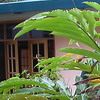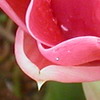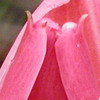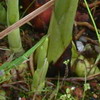
 The variety of herbs and spices used in Malaysian cooking is incredible until you realize this is where all the spices came from in the first place. Plenty of spices like cloves, cinnamon, and pepper are traded around the world. Some, for whatever reason, are still unknown outside of the region. One of these is Bunga Kantan, known in English as Torch Ginger and in Latin as Etlingera elatior. Bunga Kantan is in the ginger family, and sends green shoots out from large rhizomes just like common ginger, but the shoots are enormous, capable of growing several meters in height when the plant is happily established. Down at the base of the plant, smaller shoots are produced that at first look like the leafy ones, but soon take on a pinkish cast at the tip. These shoots, which only grow about a foot tall, slowly open up into thick, fleshly, deep pink petals that resemble flowers. I suppose they are flowers, except they don’t appear to have a reproductive function. They are gorgeous enough to cut for table ornaments, and you might sometimes see them used as such in hotels or fancy restaurants.
The variety of herbs and spices used in Malaysian cooking is incredible until you realize this is where all the spices came from in the first place. Plenty of spices like cloves, cinnamon, and pepper are traded around the world. Some, for whatever reason, are still unknown outside of the region. One of these is Bunga Kantan, known in English as Torch Ginger and in Latin as Etlingera elatior. Bunga Kantan is in the ginger family, and sends green shoots out from large rhizomes just like common ginger, but the shoots are enormous, capable of growing several meters in height when the plant is happily established. Down at the base of the plant, smaller shoots are produced that at first look like the leafy ones, but soon take on a pinkish cast at the tip. These shoots, which only grow about a foot tall, slowly open up into thick, fleshly, deep pink petals that resemble flowers. I suppose they are flowers, except they don’t appear to have a reproductive function. They are gorgeous enough to cut for table ornaments, and you might sometimes see them used as such in hotels or fancy restaurants.
[Update: they sure do have a reproductive function. My Kantan has reached enormous proportions, and left undisturbed, the flowers have developed fruit. Picture forthcoming.]
 But their primary use is culinary. Bunga Kantan has a wonderful fresh spicy flavour. It holds its pink color even when cooked, adding a lovely look to a dish. It is an essential ingredient in the famous sour fish soup, Laksa Penang. The use of it together with mint is typical for Vietnamese-style rice or noodles in fast food stalls here, though how truly that represents Vietnamese food I don’t really know. It’s a fairly expensive ingredient, as much as a ringgit a stalk, making it a worthwhile plant to grow for the kitchen.
But their primary use is culinary. Bunga Kantan has a wonderful fresh spicy flavour. It holds its pink color even when cooked, adding a lovely look to a dish. It is an essential ingredient in the famous sour fish soup, Laksa Penang. The use of it together with mint is typical for Vietnamese-style rice or noodles in fast food stalls here, though how truly that represents Vietnamese food I don’t really know. It’s a fairly expensive ingredient, as much as a ringgit a stalk, making it a worthwhile plant to grow for the kitchen.
 Bunga Kantan can also be seen in the ornamental landscape, as it is here, growing in a corner of PutraJaya, Malaysia’s new show-piece capitol city. There are varieties with different flower colors, like white, and pastel pink. The plant has an incurably wild look to it, but fits nicely in tropical-style landscapes.
Bunga Kantan can also be seen in the ornamental landscape, as it is here, growing in a corner of PutraJaya, Malaysia’s new show-piece capitol city. There are varieties with different flower colors, like white, and pastel pink. The plant has an incurably wild look to it, but fits nicely in tropical-style landscapes.
[Update: A thousand apologies! I thought I had photographed a bunga kantan in PutraJaya last year but on visiting my photo archives at work found only an ornamental banana, which I’ve duly added to the banana post. Did I really see a bunga kantan there too on that trip or is my memory playing tricks on me? – ed.]



My wife says its really hard to source this plant out of Asian. She has been wanting to make “laksa” for some time since we’re here. Mind sending us some? 🙂
Hmmm thanks for the English name u provided. I think the Baba ppl use bunga kantan a lot in their cookings. I sometimes used it in Tom Yam or Penang Laksa, although the Johor Laksa suits my tongue better 🙂 BTW, a repeat question:
What do u call limau purut, limau kesturi, and limau nipis in English?
Salam alaikum. Those are very beautiful photos – they remind me of some I took in my own garden for my blog, hoping visitors could help me identify the plants. But I bought the RHS Ecyclopedia of plants and flowers for my wife instead and this seems to have done the trick. Sorry – I know I have just gone off on a huge tangent. Do you remember Colman’s Mustard?
Br Tim
wa alaykum salam –
Thanks for writing. I do remember Coleman’s Mustard. Why do you ask?
You were talking about the varied spices used in Malaysian cooking and I was pondering what the English used to make cooking more interesting traditionally. Sorry – nonsense. Enjoy your sunny clime. All the best!
Salam alaikum,
Your post inspired me to put my garden pictures up at last. Not as nice as yours, but our camera is not great…
http://neurocentric.blogspot.com/2006/05/into-garden.html
Those are nice pictures Br. Tim. Speaking of English condiments, you may be interested in my post about the Malay origins of ketchup and probably worcestershire sauce: Malay contributions to English: Kicap
Nizar – I don’t know offhand, but i’ll look into it!
Asalamualaikum, I live is Sioux City Iowa and I had no problems getting all my spices here locally. My only problem is asam gelugor (asam keping) that I had sent from malaysia 20kg’s at a time. Recently I opened a Malaysian fusion restaurant here with olabaration of the local organic farmers and the mid-westerners have opened up their eyes to malaysian food. Now they are addicted to mamak sop ayam/kambing on those cold nights, ayam rendang pedas, and nasi minyak, nasi dagang. ome over to Sioux City if you are near us in USA and go to the Firehouse restaurant.
wa alaykum salam. Malay food available in Iowa, who would have thought! That’s great, I hope your business keeps growing. The closest thing I could find back in the Detroit area (aside from home cooking, mind you) was Vietnamese food, and they had a lot of babi on the menu.
Congratulation Sall hopefully you will make it big out there pal. Surprise and happy that the mid-westerners are now more open to taste other types of food. Food of Malaysia is actually combination from folk of different cultural background, and becomes malaysian.
Congrats Sall Hasnan for the opening of Malaysian Fusion restaurant. I know you are a good cook since knowing you in Maryville. I am now in Manchester, England about to finish my phd. My email address, roslanphd@yahoo.co.uk
All the best pal!